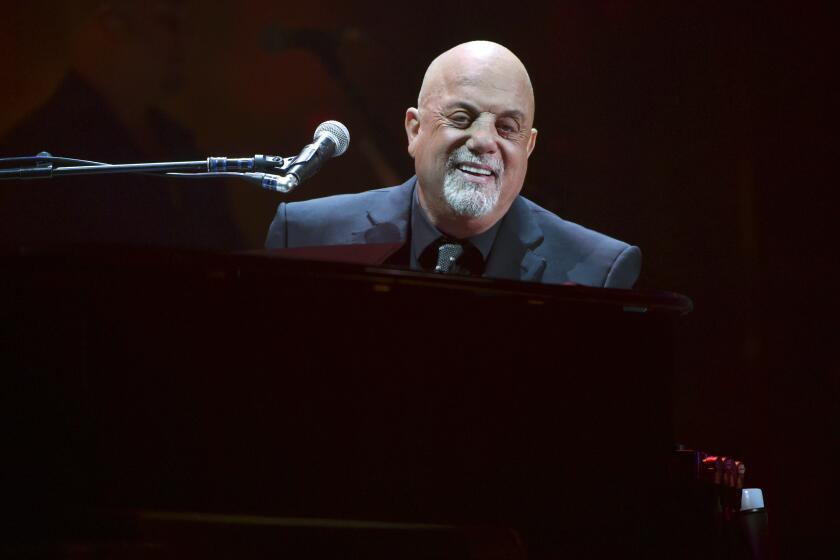The lessons of Lil Wayne’s No. 1
As music business headlines go, the one that arrived this week was a golden oldie, a half-forgotten tune from happier days: A new album soared to the top of the charts, selling more than 1 million copies in a single week. It was the first time in 39 months that any album performed that feat, and across the industry the numbers were met with shock and delight.
“Some people were blindsided by it, absolutely,” said a gleeful Sylvia Rhone, president of Universal Motown Records, the label that released “Tha Carter III,” the red-hot album from New Orleans rapper Lil Wayne.
You can understand the surprise -- not only is the music marketplace in tatters, Wayne is no household name like Eminem or Jay-Z. The most his last album, in 2005, sold in one week was 239,000 copies.
FOR THE RECORD:
Lil Wayne: A chart that accompanied an article in Saturday’s Section A about rapper Lil Wayne and his album “Tha Carter III” said it was a list of albums that sold at least 1 million copies in a week. The chart actually showed albums that sold more than 1 million copies during their first week in stores.
How did he stage a seven-digit shocker? The answer might provide a model for an industry that has suffered too many seasons of decline: “Wayne,” Rhone said, “has been super-serving his audience.”
For two years the rapper has stayed in the ears of young music fans in every way possible other than releasing an album on CD and, almost like a blogger, he has maintained something close to a daily relationship with his audience.
It’s a path that many major-label artists are pursuing, but perhaps none with the same vigor or payoff as the raunchy Louisiana rhymer. He has recorded, for instance, hundreds of informal “mixtape” albums, quick-off exercises in rhyme that often feature plenty of trash talk between rappers and are followed by fans like verbal soap operas.
“Don’t ask me how many I’ve made; that’s the hardest question in the world,” said the 25-year-old star, who was born Dwayne Michael Carter Jr. “I do know it’s a major part of this success. I was surprised by the number. Very surprised. And very happy.”
‘Constant refreshing’
The music industry is still puzzling out the Digital Age, and the most challenging question might be pricing. The British band Radiohead let fans choose the price they wanted to pay for its most recent album; Wayne’s approach is to send so much free music and other content through the pipeline that he becomes an essential figure for fans.
Wayne’s career began in the mid-1990s with the Hot Boyz, a popular rap group on the Cash Money label, and he now has an especially wide following age-wise in hip-hop. His MySpace site is ranked No. 1 among all major-label artists (it has 115 million visitors to date). Rhone said there is “constant refreshing” with new content, including video from recent concerts.
More than that, Wayne’s leering dance-floor hit “Lollipop” (the lead single off the new album) already has been downloaded as a cellphone ring tone more than 2 million times, making it the bestseller of 2008, according to Nielsen RingScan.
Then, for fans who still get their music by radio dial instead of computer keyboard, Wayne has made guest appearances on scores of songs by other artists since 2005, a good number of them hits.
He has been so prolific that Vibe, a leading hip-hop magazine, in 2007 ranked and graded songs to which he contributed that were released during that year. The list was 77 songs long. The one judged to be the best? That would be the appropriately titled “We Takin’ Over.”
Danyel Smith, editor-in-chief of Vibe, said that list was not even close to complete.
“Relentless isn’t a strong enough word for his output,” Smith said. “There is nowhere that this guy has not been. He has literally given away hundreds of songs, and I think what’s happening in hip-hop is that fans feel like here is someone who has given them so much music for free that they want to support him now. And it’s not just about quantity, it’s about quality.”
Rhone said that Wayne’s strong showing in a weak sector is evidence that CD release dates should now be viewed as an important part of the journey, not the final destination.
“Right now, artists need to engage their fans every day,” she said.
“We change the content on Wayne’s page almost daily, whether there is a new release out in the market or not. It’s a relationship, and it has really worked. Look, his 2005 album sold 1.3 million copies, total. This new album almost sold that in its first week.”
Difficult role model
Music industry executives are not known for sportsmanship, but there was a cheer in rival boardrooms for the success of “Tha Carter III.” That’s because the “event” release by the rapper spurred other titles, according to Rob Sisco, president of Nielsen Music, which tracks sales.
The week “Tha Carter III” came out, 62 albums already in the Top 200 had a sales increase of 10% or more, Sisco said. During the previous week, only 16 albums had a double-digit surge. Sisco said history shows that that sort of wide bump is a function of a catalyst release, which pulls other albums along like the tail behind a kite.
Still, the industry as a whole is finding it hard to catch any sort of tail wind. Last week, the International Federation of the Phonographic Industry, a trade group representing music companies in 73 countries, released a global analysis showing a 20-year low in music sales.
But there is some other upbeat news coming. The band Coldplay on Tuesday released its fourth album, “Viva la Vida or Death and All His Friends.” It was the most pre-ordered album in the history of iTunes, and that powered its first-day sales to 423,000 copies.
Many expect the album’s first-week total to be north of 725,000, which probably would make it next week’s No. 1. If so, that would be the first time since 2005 that albums with sales of more than 700,000 topped the chart in consecutive weeks. To understand how welcome those numbers would be, consider that last year, in one week in January, the “Dreamgirls” soundtrack managed to claim the No. 1 spot on the charts by selling a mere 60,000 copies.
Whereas Coldplay keyed its success with its iTunes partnership, other artists, including the Eagles and Journey, have entered into exclusive deals with massive retailers such as Wal-Mart.
The most common route for artists trying to energize their fans is to rely on television more than ever, whether it’s Miley Cyrus on Disney Channel, Mariah Carey visiting “ American Idol” or Josh Groban performing repeatedly on “The Oprah Winfrey Show.”
Still, it’s Wayne’s seven-digit week that is the talk of the industry at the moment, and many executives will be analyzing it for tactics that they can use with their artists.
Rhone said some of them will find that Wayne is a hard act to follow.
“He’s not your average artist, so it’s hard to make a model based on Wayne,” Rhone said. “You look at the elite -- Stevie Wonder, Marvin Gaye, Prince -- he’s on that level. He is touring 365 days a year and in the studio 365 nights a year. Not many people can pull that off.”
Business as usual
Wayne said his approach to his career is hardly calculated. “I can’t speak to nobody else and what they should do, but for me, I’m doing everything I can do, which is everything I want to do.”
What’s next for Wayne?
“We’re looking at some merchandising possibilities right now,” Rhone said, “as well as an animated series of Webisodes, more touring and endorsements.”
First up, though, is filming a new video Monday in Los Angeles for one of his songs. The title? “Got Money,” a catchy tune that the music industry would love to learn by heart.
More to Read
The biggest entertainment stories
Get our big stories about Hollywood, film, television, music, arts, culture and more right in your inbox as soon as they publish.
You may occasionally receive promotional content from the Los Angeles Times.











